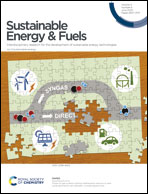GO/PEDOT modified biocathodes promoting CO2 reduction to CH4 in microbial electrosynthesis†
Abstract
Microbial electrosynthesis (MES) is a promising energy conversion technology as it can store intermittent renewable electricity while converting CO2 to value-added products using microorganisms as catalysts. However, the performance of CH4-producing MES is severely limited by the poor biofilm formation and the low loading surface area of biocathodes. Here, a novel cathode with a GO/PEDOT film was fabricated by electropolymerizing conductive poly (3,4-ethylenedioxythiophene) (PEDOT) on graphene oxide (GO) film modified carbon cloth. The GO/PEDOT modified electrode was applied to the MES of CO2 reduction to CH4, and a maximum CH4 production rate of 315.3 ± 13.2 mmol per m2 per day (7.06 ± 0.3 l per m2 per day) (the highest rate reported up to now at −0.9 V vs. Ag/AgCl) was achieved with a Faraday efficiency > 92% at an operating potential of −0.9 V vs. Ag/AgCl, which increased 3.9-fold in contrast to the bare carbon cloth cathode. Electrochemical analysis, scanning electron microscopy, and phylogenetic analyses of microbial communities indicated that the GO/PEDOT film not only improved biofilm formation, but also increased the area for microbial colonization. This study demonstrates that GO/PEDOT film modified carbon cloth is a promising material for biocathodes of CH4-producing MES and can be beneficial to the development of MES.



 Please wait while we load your content...
Please wait while we load your content...